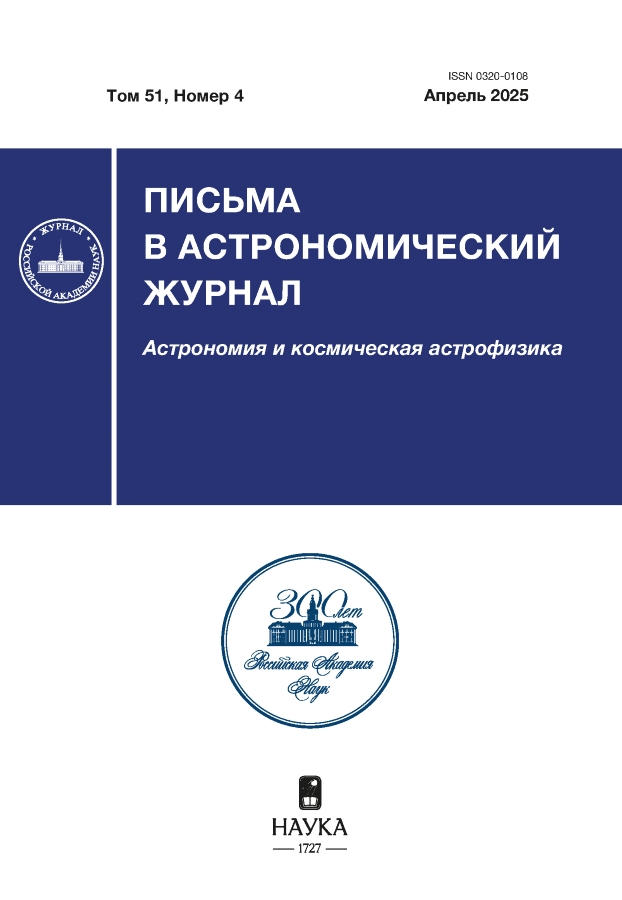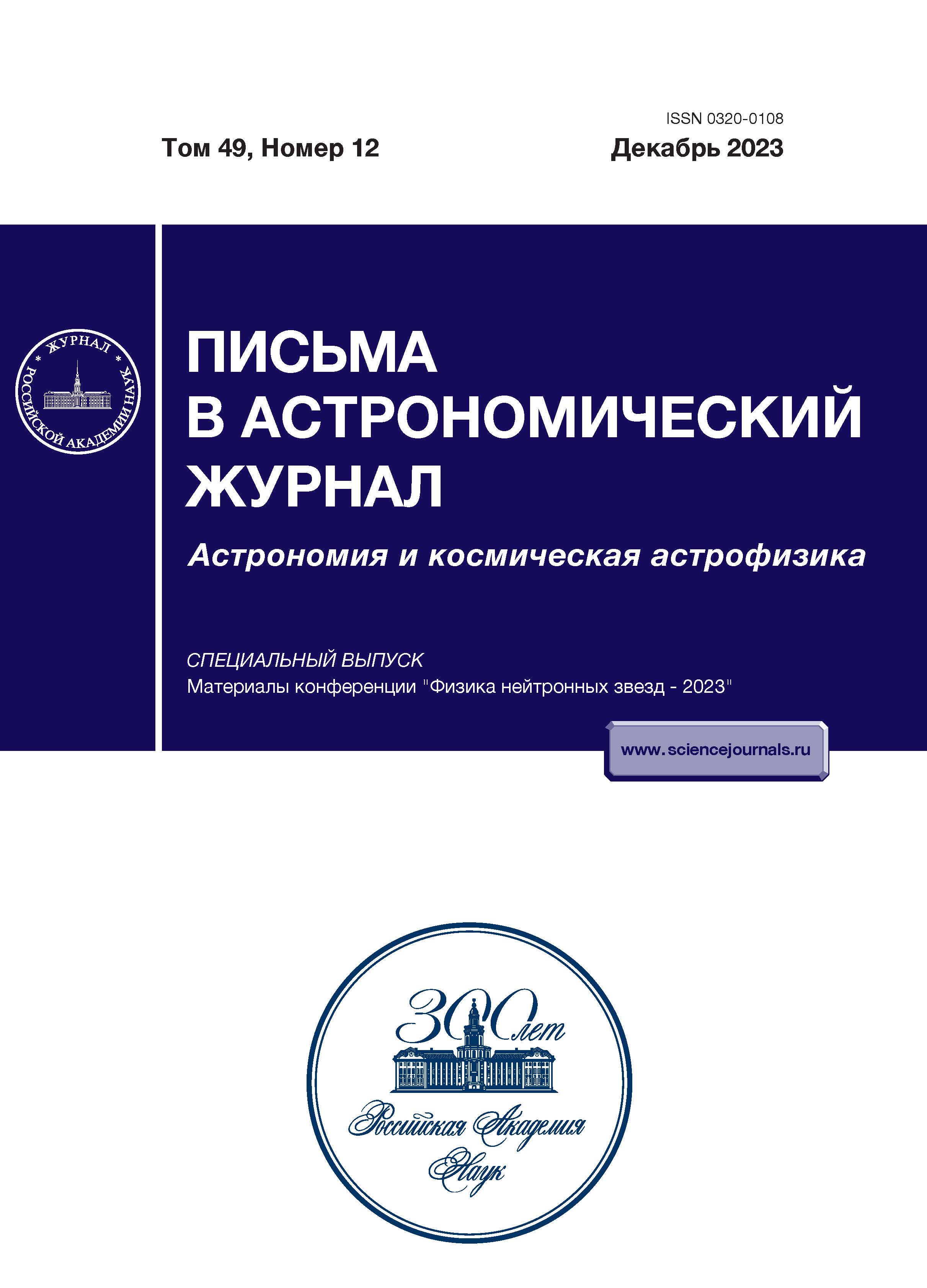Current Sheet as an Optimal Synchrotron Maser on a Radio Pulsar
- Authors: Koryagin S.A.1,2
-
Affiliations:
- A.V. Gaponov-Grekhov Institute of Applied Physics, Russian Academy of Sciences
- N.I. Lobachevsky Nizhny Novgorod State University
- Issue: Vol 49, No 12 (2023)
- Pages: 875-881
- Section: Articles
- URL: https://rjmseer.com/0320-0108/article/view/674495
- DOI: https://doi.org/10.31857/S0320010823120045
- EDN: https://elibrary.ru/RXMCRZ
- ID: 674495
Cite item
Abstract
Using a relativistic plasma with an isotropic monoenergetic distribution of electrons and
positrons as an example, we show that in the maser regime the maximum possible amplification of
synchrotron radiation at a distance of one wavelength is achieved in a medium where the magnetic energy
density is of the order of the particle energy density. This ratio of the energy densities corresponds to a
(Harris-type) current sheet. We have obtained an electron Lorentz factor of 350 and a magnetic field
strength of 10 kG in the maser radio emission region for the Crab pulsar. Our estimate suggests that
the optical and coherent radio emissions of the object originate from one synchrotron source in the form of
a current sheet. The diameter of the source must exceed the light-cylinder radius approximately by a factor
of 6 for the maser wave field to interact with particles in the linear regime, in particular, to keep its phase
velocity higher than the speed of light in a vacuum—a necessary condition for the synchrotron instability.
Keywords
About the authors
S. A. Koryagin
A.V. Gaponov-Grekhov Institute of Applied Physics, Russian Academy of Sciences; N.I. Lobachevsky Nizhny Novgorod State University
Author for correspondence.
Email: koryagin@ipfran.ru
Nizhny Novgorod, 603950 Russia; Nizhny Novgorod, 603022 Russia
References
- Арп и др. (U. Arp, G.T. Fraser, A.R. Hight Walker, T.B. Lucatorto, K.K. Lehmann, K. Harkay, N. Sereno, and K.-J. Kim), Phys. Rev. Spec. Top. Accel. Beams 4, 054401 (2001).
- Бьёрнсон и др. (C.-I. Björnsson, A. Sandberg, J. Sollerman), Astron. Astrophys. 516, A65 (2010).
- Бюхлер, Бландфорд (R. Bühler and R. Blandford), Rep. Prog. Phys. 77, 066901 (2014).
- Вестфолд (K.C. Westfold), Astrophys. J. 130, 241 (1959).
- Гинзбург и др. (V.N. Ginzburg, E.V. Katin, E.A. Khazanov, A.V. Kirsanov, V.V. Lozhkarev, G.A. Luchinin, A.N. Mal’shakov, M.A. Martyanov, et al.), AIP Conf. Proc. 1228, 71 (2010).
- Голден и др. (A. Golden, A. Shearer, R.M. Redfern, G.M. Beskin, S.I. Neizvestny, V.V. Neustroev, V.L. Plokhotnichenko, and M. Cullum), Astron. Astrophys. 363, 617 (2000).
- Дансон и др. (C.N. Danson, C. Haefner, J. Bromage, T. Butcher, J.-C.F. Chanteloup, E.A. Chowdhury, A. Galvanauskas, L.A. Gizzi, et al.), High Power Laser Sci. Engin. 7, e54 (2019).
- Железняков В.В., Излучение в астрофизической плазме (М.: Янус-К, 1997).
- Железняков В.В., ЖЭТФ 51, 570 (1966).
- Железняков и др. (V.V. Zheleznyakov, G. Thejappa, S.A. Koryagin, and R.G. Stone), Geophysical Monograph Series (Washington: Am. Geophys. Union, 2000), v. 119, p. 57.
- Кочаровский В.В., Кочаровский Вл.В., Мартьянов В.Ю., Тарасов С.В., УФН 186, 1267 (2016).
- Крузиус, Шликейзер (A. Crusius and R. Schlickeiser), Astron. Astrophys. 195, L9 (1988).
- Ландау Л.Д., Лифшиц Е.М., Теория поля (М.: Физматлит, 2003), §48, задача 2.
- Любарский (Y. Lyubarsky), Astrophys. J. 652, 1297 (2006).
- Мак-Крей (R. McCray), Science 154, 1320 (1966).
- Пьяцца и др. (A. Di Piazza, C. Müller, K.Z. Hatsagortsyan, and C.H. Keitel), Rev. Mod. Phys. 84, 1177 (2012).
- Сагив, Ваксман (A. Sagiv and E. Waxman), Astrophys. J. 574, 861 (2002).
- Согласнов (V. Soglasnov), Proc. of the 363 WE-Heraeus Seminar on Neutron Stars and Pulsars ‘‘40 years after the Discovery’’, 68 (2007).
- Соллерман и др. (J. Sollerman, J. Selsing, P.M. Vreeswijk, P. Lundqvist, and A. Nyholm), Astron. Astrophys. 629, A140 (2019).
- Спада и др. (M. Spada, M. Salvati, and F. Pacini), Astrophys. J. 511, 136 (1999).
- Тимиркеева, Малов (M. Timirkeeva and I. Malov), Astrophys. Space Sci. 365, 190 (2020).
- Уайлд и др. (J.P. Wild, S.F. Smerd, and A.A. Weiss), Ann. Rev. Astron. Astrophys. 1, 291 (1963).
- Хангулян и др. (D. Khangulyan, M.V. Barkov, and S.B. Popov), Astrophys. J. 927 (1), 2 (2022).
- Церутти и др. (B. Cerutti, J. Mortier, and A.A. Philippov), MNRAS 463, L89 (2016а).
- Церутти и др. (B. Cerutti, A.A Philippov, and A. Spitkovsky), MNRAS 457, 2401 (2016б).
- Шкловский (I.S. Shklovsky), Astrophys. J. Lett. 159, L77 (1970).
- Эйлек, Ханкинс (J.A. Eilek and T.H. Hankins), J. Plasma Phys. 82, 635820302 (2016).
Supplementary files











